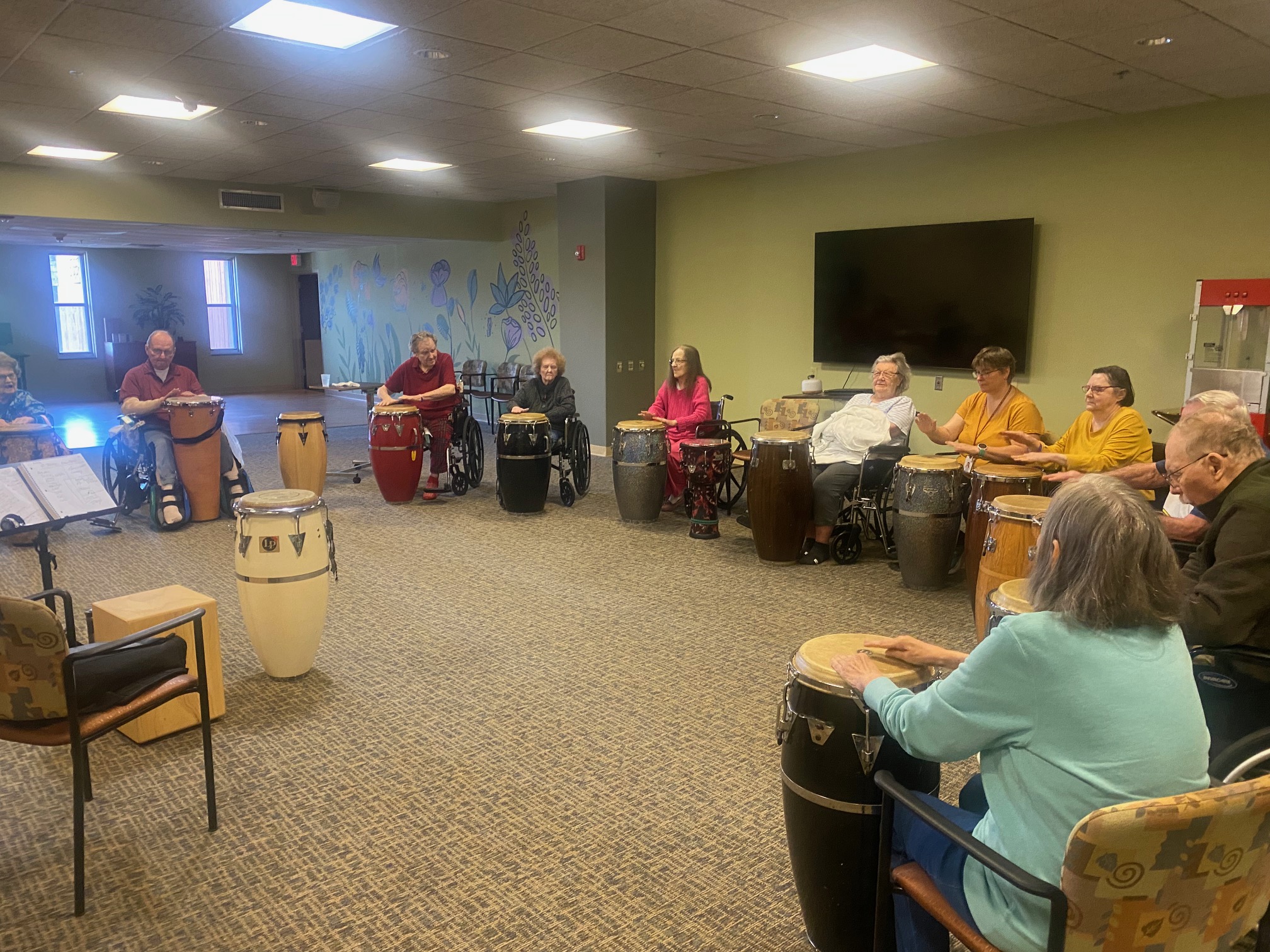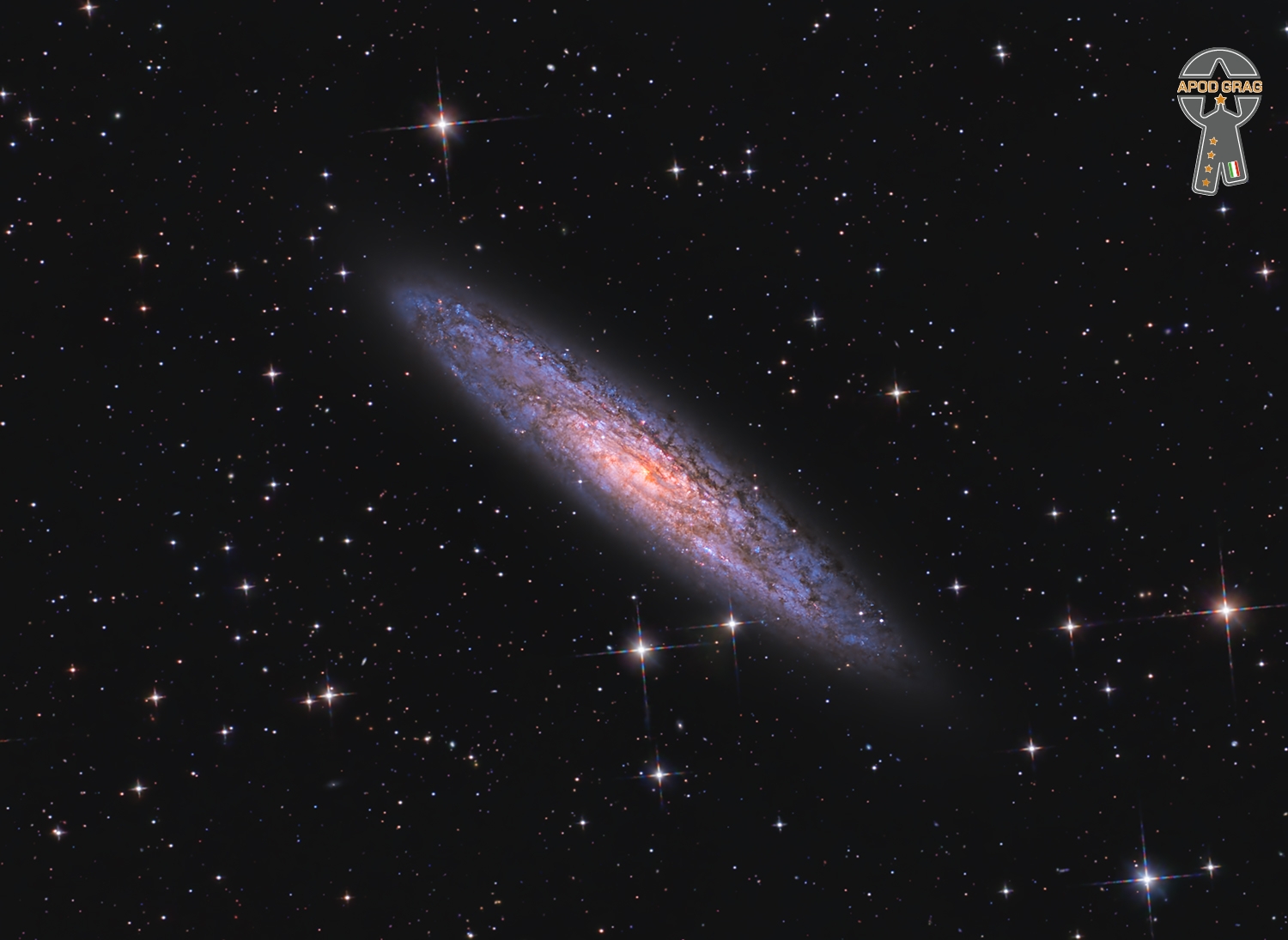4pm Yom Kippur service at Mt Zion with cantor Jennifer Strauss-Klein, Andrea Stern, Tami Morse, Pat Okeefe, Dave Burk and boom boom shaka
see full post...

This Hubble Picture of the Week includes the pithily-named galaxy SDSS J103512.07+461412.2, visible in the centre of this image as a dispersed sweep of dust and stars with a denser, brighter core. SDSS J103512.07+461412.2 is located 23 million light-years from Earth in the constellation Ursa Major. The seemingly rambling name is because this galaxy was observed as part of the Sloan Digital Sky Survey (SDSS), a massive survey that began in 2000 with the aim of observing and cataloguing vast numbers of astronomical objects. So far, it has recorded several hundred million astronomical objects.
In the early days of astronomy catalogues, astronomers painstakingly recorded individual objects one by one. As an example, the Messier catalogue includes only 110 objects, identified by the astronomer Charles Messier because they were all getting in the way of his comet-hunting efforts. As the Messier catalogue is so limited, it is sufficient to simply refer to those objects as M1 to M110. In contrast, when a survey as massive in scope as the SDSS is involved, and when huge volumes of data need to be processed in an automated manner, the names assigned to objects need to be both longer, and more informative.
To that end, every SDSS object has a designation that follows the format of: ‘SDSS J’, followed by the right ascension (RA), and then the declination (Dec). RA and Dec define the position of an astronomical object in the night sky. RA is analogous to longitude here on Earth, whilst the Dec corresponds to latitude. To be more exact, RA measures the longitudinal distance of an astronomical object from the point where the celestial equator (the mid-point between the north and south celestial poles) intersects with the ecliptic (the plane in which Earth orbits around the Sun). The entire night sky is then carved into 24 slices, known as ‘hours’, measured eastwards from that starting point (which is designated as zero hour). This means that the RA can be expressed in ‘hours’, ‘minutes’ and ‘seconds’. Dec is the angle north or south of the celestial equator, and is expressed in degrees. The RA and Dec of the objects featured in each Hubble Picture of the Week can be found on the lower right side of the webpage!
Thus, the SDSS J103512.07+461412.2 name simply tells us that the galaxy can be found 10 hours, 35 minutes and 12 seconds east of the zero-hour point on the celestial equator, and just over 46 degrees to the north of the celestial equator. So that lengthy name is really an identifier and a detailed location in one!
[Image Description: A galaxy in the centre of a wide view of space. It is surrounded by a variety of differently-shaped small galaxies. A wide and very flat spiral galaxy, and one star with four prominent diffraction spikes, are noticeable. The galaxy itself is a broad horizontal streak of tiny stars, extending left and right from a dense and bright core of stars in the centre.]

John Taylor (25 September 1942 – 17 July 2015) was a British jazz pianist, born in Manchester, England, who occasionally performed on the organ and the synthesizer.
John Taylor was a self-taught pianist. With his family, he moved from Manchester, first to the Midlands and then to Hastings where he played locally. In 1964, Taylor became a civil servant, moved to London and became involved in the free jazz scene.
see full post...Erik Darling (September 25, 1933 – August 3, 2008) was an American singer-songwriter and a folk musicartist. He was an important influence on the folk scene in the late 1950s and early 1960s.
Darling was born in Baltimore, Maryland. He entered New York University in the early 1950s, but soon abandoned higher education. Inspired by the folk music group The Weavers, in the 1950s, he formed The Tunetellers, which evolved into The Tarriers with actor/singer Alan Arkin. Their version of the “Banana Boat Song” reached No. 4 on the Billboard chart.
see full post...Dmitri Dmitriyevich Shostakovich (25 September [O.S. 12 September] 1906 – 9 August 1975) was a Soviet-era Russian composer and pianist who became internationally known after the premiere of his First Symphony in 1926 and was regarded throughout his life as a major composer.
Shostakovich achieved early fame in the Soviet Union, but had a complex relationship with its government. His 1934 opera Lady Macbeth of Mtsensk was initially a success, but eventually was condemned by the Soviet government, putting his career at risk. In 1948 his work was denounced under the Zhdanov Doctrine, with professional consequences lasting several years. Even after his censure was rescinded in 1956, performances of his music were occasionally subject to state interventions, as with his Thirteenth Symphony(1962). Shostakovich was a member of the Supreme Soviet of the RSFSR (1947) and the Supreme Soviet of the Soviet Union (from 1962 until his death), as well as chairman of the RSFSR Union of Composers (1960–1968). Over the course of his career, he earned several important awards, including the Order of Lenin, from the Soviet government.
Shostakovich combined a variety of different musical techniques in his works. His music is characterized by sharp contrasts, elements of the grotesque, and ambivalent tonality; he was also heavily influenced by neoclassicism and by the late Romanticism of Gustav Mahler. His orchestral works include 15 symphoniesand six concerti (two each for piano, violin, and cello). His chamber works include 15 string quartets, a piano quintet, and two piano trios. His solo piano works include two sonatas, an early set of 24 preludes, and a later set of 24 preludes and fugues. Stage works include three completed operas and three ballets. Shostakovich also wrote several song cycles, and a substantial quantity of music for theatre and film.
Shostakovich’s reputation has continued to grow after his death. Scholarly interest has increased significantly since the late 20th century, including considerable debate about the relationship between his music and his attitudes toward the Soviet government.
see full post...Samuel Carthorne Rivers (September 25, 1923 – December 26, 2011) was an American jazz musician and composer. Though most famously a tenor saxophonist, he also performed on soprano saxophone, bass clarinet, flute, harmonica, piano and viola.
Active in jazz since the early 1950s, he earned wider attention during the mid-1960s spread of free jazz. With a thorough command of music theory, orchestration and composition, Rivers was an influential and prominent artist in jazz music.
Rivers was born in El Reno, Oklahoma, United States. His father was a gospel musician who had sung with the Fisk Jubilee Singers and the Silverstone Quartet, exposing Rivers to music from an early age. His grandfather was Marshall W. Taylor, a religious leader from Kentucky. Rivers was stationed in California in the 1940s during a stint in the Navy. Here he performed semi-regularly with blues singer Jimmy Witherspoon. Rivers moved to Boston, Massachusetts, in 1947, where he studied at the Boston Conservatory with Alan Hovhaness.
see full post...The Sculptor Galaxy (also known as the Silver Coin, Silver Dollar Galaxy, NGC 253, or Caldwell 65) is an intermediate spiral galaxy in the constellation Sculptor. The Sculptor Galaxy is a starburst galaxy, which means that it is currently undergoing a period of intense star formation.

Theodore “Fats” Navarro (September 24, 1923 – July 6, 1950) was an American jazz trumpet player. He was a pioneer of the bebop style of jazz improvisation in the 1940s. He had a strong stylistic influence on many other players, including Clifford Brown.
Navarro was born in Key West, Florida, United States, of Cuban, African, and Chinese descent. He began playing piano at age six, but did not become serious about music until he began playing trumpet at the age of thirteen. He was a childhood friend of drummer Al Dreares. By the time he graduated from Douglass High School, he wanted to be away from Key West and joined a dance band headed for the Midwest.
Navarro gained valuable experience touring in bands, including Snookum Russell‘s territory band, where he met and influenced a young J.J. Johnson. Tiring of the life on the road, Navarro settled in New York City in 1946, where his career took off. He met and played with, among others, Charlie Parker. But Navarro was in a position to demand a high salary and did not join one of Parker’s regular groups. He also developed a heroin addiction, tuberculosis, and a weight problem. (He was nicknamed “Fat Girl” due to his weight and high speaking voice.) These afflictions led to a slow decline in health. Navarro was hospitalized on July 1, 1950, and he died five days later on July 6 at the age of 26. His last performance was with Charlie Parker on July 1 at Birdland.
see full post...Lemon Henry “Blind Lemon” Jefferson (September 24, 1893 – December 19, 1929) was an American blues and gospel singer-songwriter and musician. He was one of the most popular blues singers of the 1920s and has been called the “Father of the Texas Blues“.
Due mainly to his high-pitched voice and the originality of his guitar playing, Jefferson’s performances were distinctive. His recordings sold well, but he was not a strong influence on younger blues singers of his generation, who could not imitate him as easily as they could other commercially successful artists. Later blues and rock and roll musicians, however, did attempt to imitate both his songs and his musical style.
Jefferson was born blind, near Coutchman, Texas. He was the youngest of seven (or possibly eight) children born to Alex and Clarissa Jefferson, who were African-American sharecroppers. Jefferson died in Chicago at 10:00 a.m. on December 19, 1929, of what his death certificate said was “probably acute myocarditis“. For many years, rumors circulated that a jealous lover had poisoned his coffee, but a more likely explanation is that he died of a heart attack after becoming disoriented during a snowstorm. Some have said that he died of a heart attack after being attacked by a dog in the middle of the night.
see full post...see full post...By now my face was flooded with streams of memories Pouring over my entire life; You running by my side, around and around, weaving how our lives Were so intertwined, a Fabric of Yesterdays, not now’s no more; My baby-my life, daddy-daddy look, do you See My Face in the Moon?”
NGC 7380 is a young open clusterof stars in the northern circumpolar constellation of Cepheus, discovered by Caroline Herschel in 1787. The surrounding emission nebulosity is known colloquially as the Wizard Nebula, which spans an angle of 25′. German-born astronomer William Herschel included his sister’s discovery in his catalog, and labelled it H VIII.77. The nebula is known as S 142 in the 1959 Sharpless catalog (Sh2-142). It is extremely difficult to observe visually, usually requiring very dark skies and an O-III filter. The NGC 7380 complex is located at a distance of approximately 8.5 kilolight-years from the Sun, in the Perseus Arm of the Milky Way. 
Mohammad-Reza Shajarian (Persian: محمدرضا شجريان; Persian pronunciation:[mohæmːæd ɾeˈzɒː ʃædʒæɾiˈɒːn], 23 September 1940 – 8 October 2020) was an Iranian singer and master(Ostad) of Persian traditional music. He was also known for his skills in Persian calligraphy and humanitarian activities.Shajarian started his singing career in 1959 at Radio Khorasan, rising to prominence in the 1960s with his distinct singing style. His main teachers were Ahmad Ebadi, Esmaeil Mehrtash, Abdollah Davami, and Nour-Ali Boroumand. He also learned the vocal styles of singers from previous generations, including Reza Gholi Mirza Zelli, Fariborz Manouchehri, Ghamar Molouk Vaziri, Eghbal Azar, and Taj Isfahani. He has cited legendary Persian tar soloist Jalil Shahnaz as highly influential to his development, indicating that he has often tried to mimic Shahnaz’s playing style in his singing.
see full post...Leslie Coleman McCann (born September 23, 1935 Lexington, KY) is an American jazz pianist and vocalist.
see full post...Ray Charles Robinson Sr. (September 23, 1930 – June 10, 2004 Albany, GA) was an American singer, songwriter and pianist. He is regarded as one of the most iconic and influential singers in history, and was often referred to by contemporaries as “The Genius”. Among friends and fellow musicians he preferred being called “Brother Ray”.Charles was blinded during childhood, possibly due to glaucoma. Charles pioneered the soul musicgenre during the 1950s by combining blues, jazz, rhythm and blues, and gospel styles into the music he recorded for Atlantic Records. He contributed to the integration of country music, rhythm and blues, and pop music during the 1960s with his crossover success on ABC Records, notably with his two Modern Soundsalbums. While he was with ABC, Charles became one of the first black musicians to be granted artistic control by a mainstream record company.
see full post...
